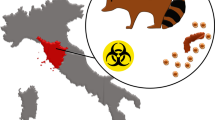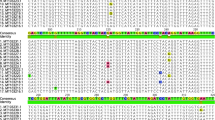Abstract
Alaria alata is a trematode of carnivores from Europe. The mesocercarial stage was recently identified in wild boar meat from Europe. Previous histopathologic studies showed the presence of unidentified parasitic cysts within the tongues of raccoons from northern Germany. For identification of the parasite species, tissue samples of 105 raccoons originating from a National Park in northern Germany and from Berlin metropolitan area were collected. Histological examination of cryotome sections of frozen as well as paraffin-embedded tongues were used to identify parasite cysts. These were located in the connective and adipose tissue and in close proximity to small arterioles, suggesting a hematogenous spread of the parasite. Often, cysts were surrounded with mild infiltration by inflammatory cells. Additionally, mesocercariae were isolated from defrosted tongue samples of 11 raccoons. Molecular-biology assays confirmed the parasite species as A. alata. Except for one positive raccoon from Berlin City, all other positive raccoons originated from the sylvan Müritz National park, indicating an abundance of intermediate hosts in this area. Our results show that raccoons can act as paratenic hosts for A. alata and extend the broad host range of this parasite to a species introduced into Germany.



Similar content being viewed by others
Abbreviations
- Bp:
-
Base pairs
- DNA:
-
Deoxyribonucleic acid
- HE:
-
Hematoxylin–eosin
- ID:
-
Identification
- LR:
-
Lewitz region
- MNP:
-
Müritz National Park
- NTC:
-
Nontemplate control
- Syn:
-
Synonym
References
Andreas K (2006) Helminthen einheimischer Froschlurche. Dissertation, Freie Universität Berlin
Anonymous (2003) Einstufung von Organismen. Parasiten. Herausgegeben vom Bundesamt für Umwelt, Wald und Landschaft (BUWAL), Bern. Available at website http://www.umweltschweiz.ch/imperia/md/content/stobobio/biotech/12.pdf
Beaver PC, Little MD, Tucker CF, Reed RJ (1977) Mesocercaria in the skin of a man in Lousiana. Am J Trop Med Hyg 26:422–426
Beltrán-Beck B, García FJ, Gortázar C (2011) Raccoons in Europe: disease hazards due to the establishment of an invasive species. Eur J Wildl Res 58:5–15
BfR (2007) Federal Institute for Risk Assessment, Wildschweinefleisch kann den gefährlichen Dunker’schen Muskelegel enthalten. Opinion No. 027/2007 BfR
Borgsteede FHM (1984) Helminth parasites of wild foxes (Vulpes vulpes L.) in The Netherlands. Parasitol Res 70:281–285
Castro O, Venzal JM, Felix ML (2008) Two new records of helminth parasites of domestic cat from Uruguay: Alaria alata (Goeze, 1782) (Digenea, Diplostomatidae) and Lagoschilascaris major (Leiper, 1910) (Nematoda, Ascrididae). Vet Parasitol 160:344–347
Fernandez BJ, Cooper JD, Cullen JB, Freeman RS, Ritchie AC, Scott AA, Stuart PC (1976) Systemic infection with Alaria americana (Trematoda). Can Med Assoc J 115:1111–1114
Fried B, Abruzzi A (2010) Food-borne trematode infections of humans in the United States of America. Parasitol Res 106:1263–1280
Iastreb VB, Gorokhov VV, Shestakov AM (2005) To the detection of the trematode mesocercariae Alaria alata in the blood of domestic dogs and cats. Med Parazitol 4:48–51
Jaskšić S, Uhitil S, Vučemilo Z (2002) Nachweis von Mesozerkarien des Saugwurms Alaria alata im Wildscheinefleisch. Z Jagdwiss 48:203–207
Johnson A (1979) Morphology and life history of Alaria mustelae Bosma 1931 (Trematoda: Diplostomatidae) from Minnesota mustelids. J Parasitol 65:154–160
Kramer MH, Eberhard ML, Blakenberg TA (1996) Respiratory symptoms and subcutaneous granuloma caused by mesocercariae: a case report. Am J Trop Med Hyg 55:447–448
Machnicka B, Dziemian E, Rocki B, Kołodziej-Sobocińska M (2003) Detection of Echinococcus multilocularis antigens in faeces by ELISA. Parasitol Res 91:491–496
Michler F-U, Michler BA (2012) Ökologische, ökonomische und epidemiologische Bedeutung des Waschbären (Procyon lotor) in Deutschland – eine aktuelle Übersicht. Beitr Jagd- u Wildforsch
Mihalca AD, Gherman C, Ghira I, Cozma V (2007) Helminth parasites of reptiles (Reptilia) in Romania. Parasitol Res 101:491–492
Möhl K, Große K, Hammedy A, Wüste T, Kabelitz P, Lücker E (2009) Biology of Alaria spp. and human exposition risk to Alaria mesocercariae—a review. Parasitol Res 105:1–15
Murphy TM, O’Connell J, Berzano M, Dold C, Keegan JD, McCann A, Murphy D, Holden NM (2012) The prevalence and distribuition of Alaria alata, a potential zoonotic parasite, in foxes in Ireland. Parasitol Res 111:283–290
Odening K (1963) Zur Diagnostik der Mesocercarie von Alaria alata, eines möglichen Parasiten des Menschen in Europa, anhand experimenteller Befunde beim Affen. Mber Dtsch Akad Wiss Berl 5:385–390
Portier J, Joudet D, Ferté H, Gibou O, Heckmann A, Boireau P, Vallée I (2011) New data in France on the trematode Alaria alata (Goeze, 1792) obtained during Trichinella inspections. Parasite 18:271–275
Riehn K, Hamedy A, Große K, Zeitler L, Lücker E (2010) A novel detection method for Alaria alata mesocercariae in meat. Parasitol Res 107:213–220
Riehn K, Hamedy A, Alter T, Lücker E (2011) Development of a PCR approach for differentiation of Alaria spp. mesocercariae. Parasitol Res 108:1327–1332
Riehn K, Hamedy A, Große K, Wüste T, Lücker E (2012) Alaria alata in wild boars (Sus scrofa, Linnaeus, 1758) in the eastern parts of Germany. Parasitol Res 111:1857–1861
Ruas JL, Müller G, Farias NA, Gallina T, Lucas AS, Pappen FG, Sinkoc AL, Brum JG (2008) Helminths of pampas fox, Pseudalopex gymnocercus (Fischer, 1814) and crab-eating fox, Cerdocyon thous (Linnaeus, 1766) in the South of the State of Rio Grande do Sul, Brazil. Rev Bras Parasitol Vet 17:87–92
Shoop WL, Corkum KC (1981) Epidemiology of Alaria marcianae mesocercariae in Lousiana. J Parasitol 67:928–931
Shoop W, Corkum K (1984) Pathway of mesocercariae of Alaria marcianae (Trematoda) through the mammary glands of lactating mice. J Parasitol 70:333–336
Travassos L, Freitas JFK, Kohn A (1969) Trematódeos do Brasil. Mem Inst Oswaldo Cruz 67:1–886
Acknowledgments
The authors thank Dr. U. Wittstatt from the State Laboratory Berlin-Brandenburg for providing raccoon samples, Marcus Borcherts from the Technical University of Dresden for his commitment to gather raccoons in Lewitz, and to Z. Mezoe, D. Krumnow, and M. Biering for their excellent technical assistance. We are grateful to the German Academic Exchange Service (DAAD) and the Mexican Council of Science and Technology (CONACyT) for financial support (fellowship of Z. M. Rentería-Solís). Additionally, this study was financially supported by the German Federal Ministry of Food, Agriculture, and Consumer Protection (BMELV) through the Federal Office for Agriculture and Food (BLE), grant number 2810HS017.
Author information
Authors and Affiliations
Corresponding author
Rights and permissions
About this article
Cite this article
Rentería-Solís, Z.M., Hamedy, A., Michler, FU. et al. Alaria alata mesocercariae in raccoons (Procyon lotor) in Germany. Parasitol Res 112, 3595–3600 (2013). https://doi.org/10.1007/s00436-013-3547-4
Received:
Accepted:
Published:
Issue Date:
DOI: https://doi.org/10.1007/s00436-013-3547-4




